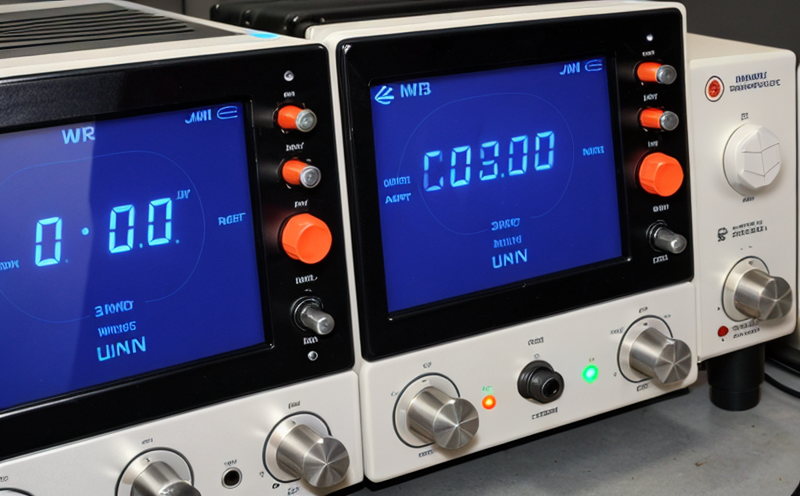ETSI EN 302 609 RF Testing of Ultra-Wideband IoT Devices
The ETSI EN 302 609 standard specifies the technical requirements for radio equipment operating in the ultra-wideband (UWB) frequency range, which is crucial for ensuring interoperability and compliance with regulatory standards. This standard is particularly important for testing Ultra-Wideband IoT devices that are designed to operate across a broad spectrum of frequencies.
The primary objective of ETSI EN 302 609 testing is to ensure that these devices meet the stringent performance criteria set forth by the European Telecommunications Standards Institute (ETSI). This includes compliance with electromagnetic compatibility (EMC) and emission requirements, as well as ensuring robust signal quality within the specified frequency bands.
Testing under this standard involves a series of rigorous procedures aimed at evaluating various aspects of the device's performance. These include:
- Signal integrity verification
- Frequency band compliance checks
- Emission level assessments
- Interference mitigation analysis
- Sensitivity and dynamic range testing
The process also involves extensive environmental and operational testing to ensure that the device functions reliably under different conditions. This includes temperature, humidity, and altitude variations, as well as electromagnetic interference from other devices.
To achieve comprehensive testing, specialized equipment is required, including high-precision RF analyzers, spectrum analyzers, and signal generators capable of operating across the UWB frequency range. The use of advanced simulation tools can also enhance the testing process by providing insights into potential real-world scenarios where the device may operate.
Accurate and detailed reporting is essential in this process to document all test results comprehensively. This report should include not only pass/fail results but also provide a thorough analysis of any deviations from the expected performance criteria. It is crucial for stakeholders, including quality managers, compliance officers, R&D engineers, and procurement teams, to understand these details.
The importance of ETSI EN 302 609 testing cannot be overstated in ensuring that UWB IoT devices meet the stringent requirements set by regulatory bodies. This not only ensures interoperability but also enhances safety and reliability for end-users. By adhering to this standard, manufacturers can confidently enter the European market knowing their products comply with all necessary regulations.
Why It Matters
The implementation of ETSI EN 302 609 testing is critical for several reasons. Firstly, it ensures that UWB IoT devices operate within the specified frequency bands without causing interference to other devices operating in adjacent frequencies. This is particularly important given the rapid growth in IoT device usage and the need to maintain a stable and secure communication environment.
Secondly, compliance with this standard helps manufacturers meet regulatory requirements set by ETSI and other international bodies. Failure to comply can result in product recalls or even legal action, which can be costly and damaging to a company's reputation.
Thirdly, ensuring interoperability is a key benefit of ETSI EN 302 609 testing. By adhering to these standards, manufacturers can ensure that their devices work seamlessly with other UWB IoT products from different vendors. This enhances the overall functionality and user experience of IoT ecosystems.
Lastly, robust signal quality is a critical aspect of ETSI EN 302 609 testing. Ensuring that signals are transmitted reliably across the entire frequency range not only improves performance but also extends battery life by optimizing energy consumption.
Environmental and Sustainability Contributions
The implementation of ETSI EN 302 609 testing has several environmental benefits. By ensuring that UWB IoT devices operate within the specified frequency bands, this standard helps reduce electromagnetic interference, which in turn reduces the need for recalibration and repair of affected equipment.
- Reduces energy consumption by optimizing signal transmission
- Avoids waste from non-compliant products being returned to manufacturers or discarded improperly
- Promotes the use of UWB IoT devices that are more reliable and efficient, thus extending their operational life
In addition, compliance with this standard fosters a culture of innovation in the development of eco-friendly technologies. By adhering to these stringent testing procedures, manufacturers can introduce products that are not only compliant but also environmentally sustainable.
Use Cases and Application Examples
- Smart Home Devices: UWB IoT devices tested under ETSI EN 302 609 can enhance the performance of smart home systems by ensuring reliable communication between various components. This includes lighting, security systems, and entertainment devices.
- Healthcare Monitoring: In medical applications, such as wearable health monitors or patient tracking systems, ETSI EN 302 609 compliance ensures that these devices operate reliably even in crowded RF environments.
- Industrial Automation: UWB IoT devices tested according to this standard can improve the efficiency of industrial processes by enabling precise positioning and communication between robots and other automation equipment.
- Automotive Industry: In the automotive sector, ETSI EN 302 609 compliance is essential for ensuring that connected vehicles operate safely and efficiently. This includes vehicle-to-vehicle (V2V) communication and infotainment systems.
The application of UWB IoT devices in these sectors highlights the importance of stringent testing standards like ETSI EN 302 609 to ensure reliable, secure, and interoperable solutions. These real-world examples demonstrate how compliance with this standard can lead to significant improvements in performance and user experience.





